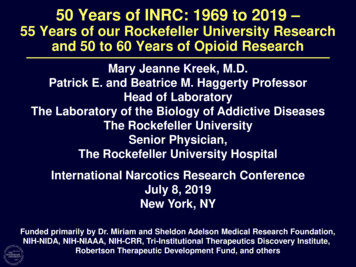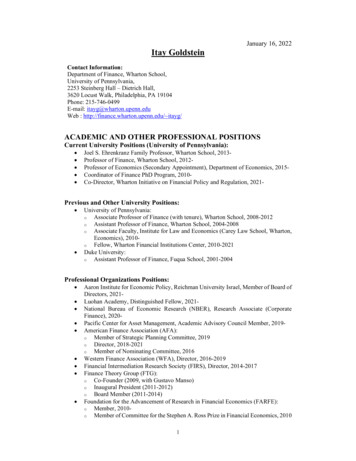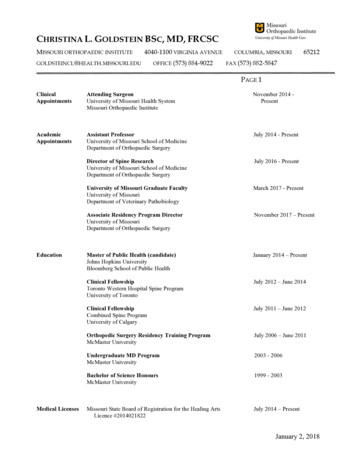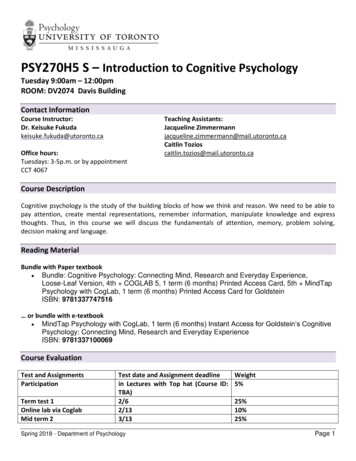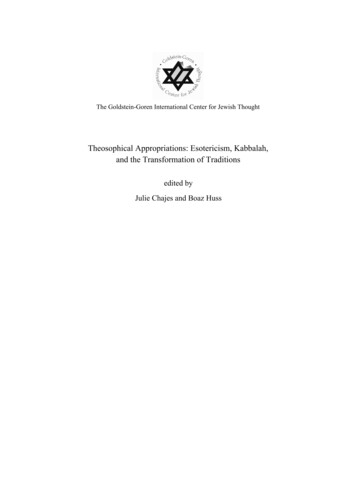
Transcription
The Goldstein-Goren Library of Jewish Thought Howard Kreisel, editor Gerald J. Blidstein (ed.), Sabbath: Idea, History, Reality, 2004 יעקב בלידשטיין , עיונים במחשבת ההלכה והאגדה , תשס"ד זאב גריס , חיים קרייסל , בועז הוס )עורכים( , שפע טל : עיונים במחשבת ישראל ותרבות יהודית מוגשים לברכה זק , תשס"ד Howard Kreisel (ed.), Study and Knowledge in Jewish Thought, 2006 חיים קרייסל )עורך( , לימוד ודעת במחשבה יהודית )כרך ב( , תשס"ו Chanita Goodblatt, Howard Kreisel (eds.), Tradition, Heterodoxy and Religious Culture: Judaism and Christianity in the Early Modern Period, 2006 אורי ארליך , חיים קרייסל , דניאל י' לסקר )עורכים( , על פי הבאר : מחקרים בהגות יהודית ובמחשבת ההלכה מוגשים ליעקב בלידשטיין , תשס"ח חיים קרייסל , בועז הוס , אורי ארליך )עורכים( , סמכות רוחנית : מאבקים על כוח תרבותי בהגות היהודית , תש"ע עדיאל קדרי , עיוני תשובה : הלכה , הגות ומחשבה חינוכית בהלכות תשובה לרמב"ם , תש"ע ניחם רוס , מסורת אהובה ושנואה : זהות יהודית מודרנית וכתיבה ניאו–חסידית בפתח המאה העשרים תש"ע Boaz Huss (ed.), Kabbalah and Contemporary Spiritual Revival, 2011 דניאל י' לסקר )עורך( , מחשבת ישראל ואמונת ישראל , תשע"ב משה חלמיש , חקרי קבלה ותפילה , תשע"ב אורי ארליך )עורך( , התפילה בישראל : היבטים חדשים , תשע"ו Julie Chajes and Boaz Huss ( e d s . ) , Theosophical Appropriations:Esotericism, Kabbalah, and the Transformation of Traditions, 2016 מקורות לחקר מחשבת ישראל לוית חן לר' לוי בן אברהם : איכות הנבואה וסודות התורה , מהדורת חיים קרייסל , תשס"ז מעיין עין יעקב לר' משה קורדובירו , מהדורת ברכה זק , תשס"ט כתבי ר' משה אבן תבון , מהדורת חיים קרייסל , קולט סיראט , אברהם ישראל , תש"ע דרשות ר' זרחיה הלוי סלדין , מהדורת ארי אקרמן , תשע"ב ממעיינות ספר אלימה לר' משה קורדובירו ומחקרים בקבלתו , מהדורת ברכה זק , תשע"ג לוית חן לר' לוי בן אברהם : סתרי האמונה ושער ההגדה , מהדורת חיים קרייסל , תשע"ד
Theosophical Appropriations:Esotericism, Kabbalah, and theTransformation of Traditionsedited byJulie Chajes and Boaz HussBen-Gurion University of the Negev Press
The Goldstein-Goren Library of Jewish ThoughtPublication no. 21Distribution: The Bialik Institute, Jerusalemwww.bialik-publishing.co.ilISBN 978-965-536-179-7 All Rights reserved toBen-Gurion University of the Negev PressBeer Sheva, 2016Printed in Israel
Dedicated to the memory ofNicholas Goodrick-Clarke(1953-2012)
ContentsJulie Chajes andBoaz HussIntroduction9I. Theosophical TransformationsJulie ChajesIsaac LubelskyConstruction Through Appropriation:Kabbalah in Blavatsky’s Early Works33Friedrich Max Müller vs. MadameBlavatsky: A Chronicle of a (Very)Strange Relationship73John Patrick Deveney The Two Theosophical Societies:Prolonged Life, Conditional Immortality,and the Individualized Immortal Monad 93Tomer PersicoA Pathless Land: Krishnamurti and theTradition of No Tradition115II. Kabbalistic AppropriationsBoaz HussEugene KuzminAndreas KilcherOlav Hammer“Qabbalah, the Theos-Sophia of theJews:” Jewish Theosophists and theirPerceptions of Kabbalah137Maksimilian Voloshin and theKabbalah167Kabbalah and Anthroposophy:A Spiritual Alliance According toErnst Müller197Jewish Mysticism Meets the Age ofAquarius: Elizabeth Clare Prophet onthe Kabbalah223III. Global AdaptationsShimon LevGandhi and his Jewish TheosophistSupporters in South Africa245
Victoria FerentinouKarl BaierMassimo IntrovigneHelmut ZanderLight From Within or Light FromAbove? Theosophical Appropriations inEarly Twentieth-Century Greek Culture273Theosophical Orientalism and theStructures of Intercultural Transfer:Annotations on the Appropriation ofthe Cakras in Early Theosophy309Lawren Harris and the TheosophicalAppropriation of Canadian Nationalism355Transformations of Anthroposophyfrom the Death of Rudolf Steiner tothe Present Day387
IntroductionJulie Chajes and Boaz HussAppreciation of the historical importance of the Theosophical Society(henceforth, TS) and related movements is growing, and rightly so, yetthe extent of theosophical influences can still be surprising, even toscholars in the field. The chapters of this volume contribute to ourincreasing recognition of the global impact of the TS and its ideas andillustrate lesser-known instances of theosophical appropriation aroundthe world.From its very beginning, the TS was an international movement.Its founders were an American lawyer and journalist, Colonel HenrySteel Olcott (1832-1907), an Irish-American lawyer, William QuanJudge (1851-1896), and a Russian occultist writer and adventurer,Madame Helena Petrovna Blavatsky (1831-1891). Following itsfounding in New York in 1875, the TS soon became a worldwideorganization. In 1879, its headquarters moved to India, first to Bomaby,and later to Adyar, Madras. From the 1880’s, theosophical lodgeswere established around the world: in America, Europe, Asia, Africa,and Australia. Today, the movement has branches in about sixtycountries. The first objective of the Society (as formulated in 1896)was “to form a nucleus of the universal brotherhood of humanitywithout distinction of race, creed, sex, caste or color,” and it was opento members of diverse religious, national, and ethnic backgrounds.The universalistic nature of the TS was expressed in its interest indifferent religious and esoteric traditions: first, in Western esoteric,ancient Egyptian, and Kabbalistic doctrines, and later, in Hindu andBuddhist ones. As a movement, Theosophy encouraged the comparativestudy of religion and integrated into its teachings concepts and themesderived from a large variety of contexts. Unlike other esotericmovements, the TS included many non-Christian and non-Westernmembers from the outset. These members participated in theosophicaladaptations and interpretations of their traditions. Despite these9
Julie Chajes and Boaz Hussinterpretations being offered by adherents of the traditions themselves,they were usually predicated on a modern esoteric perspective, withina Western discursive framework. Theosophical appropriations had aconsiderable impact on the way different religious traditions wereperceived in modern Western culture. In particular, they had a decisiveand significant impact on new developments in, and transformationsof, modern Kabbalistic, Hindu, and Buddhist currents.The chapters that follow are the product of an international workshopheld at Ben-Gurion University in December 2013, funded by the IsraelScience Foundation (ISF) and the Goldstein-Goren Center for JewishThought at Ben-Gurion University. Scholars attended the conferencefrom Israel, Austria, Switzerland, Denmark, Greece, Italy, Holland,the United States, Japan, and Sri Lanka. The workshop was part of afour-year research project funded by the ISF (Grant 774/10) on Kabbalahand the Theosophical Society.As part of that project, we studied Jewish involvement in the TS,the formation of Jewish theosophical groups, and the adaptation andinterpretation of Kabbalah by Jewish and non-Jewish theosophists.These topics were also central to the workshop, a centrality reflectedin this volume, with its section on Kabbalistic appropriations. Theworkshop considered Judaism’s often-ambivalent placement betweenthe categories of “East” and “West” and the TS’s role in the constructionof modern Jewish and non-Jewish identities in relation to thosecategories, inter alia. Since we believe questions relating to Jewishtheosophists and the appropriations of Kabbalah in the TS should beunderstood in wider context, the workshop also examined theosophicaladaptations in other cultures and traditions as well, especially withinAnthroposophy, which emerged directly from the TS.The chapters in the volume examine intersections betweentheosophical thought with areas as diverse as the arts, literature, andpoetry, scholarship, modern interpretations of Judaism and of Kabbalah,Orientalism, and politics, especially nationalism. How may we explainthe extent of these theosophical influences? Although they are verydifferent from one another, these chapters join each other in pointingtowards congruencies between theosophical ideas and the cultural logicof a wide range of contemporary currents. In other words, we suggestthat Theosophy was exceptionally successful (and influential) because10
Introductionit was a key expression of some of the central cultural, intellectual,and political developments of the period. Yet, for all these congruenciesbetween theosophical, artistic, literary, political and scholarly themes,there were also important differences and tensions. Max Müller’snegative stance towards his theosophical admirer, Madame Blavatsky,and Gandhi’s ambivalent attitude towards the TS (even though it hadinfluenced him) are just two of the examples discussed in the chaptersthat follow.Chapter OutlinesThe present volume includes thirteen chapters, each of them a fascinatingcase study of a theosophical appropriation of a different type and in adifferent context. They are divided into three thematic sections:Theosophical Transformations, Kabbalistic Appropriations, and GlobalAdaptations. The first section, Theosophical Transformations, focuseson the appropriations that took place in the early TS, especially in thethought of Madame Blavatsky.In the opening paper, Julie Chajes discusses two of Blavatsky’searly works that refer to Kabbalah: “A Few Questions to Hiraf” (1875)and Isis Unveiled (1877). The chapter elucidates Blavatsky’s doctrinesof Kabbalah in those texts, each of which have distinct emphases. In“A Few Questions,” Blavatsky emphasized Rosicrucianism andSpiritualism, identifying Kabbalah with the current doctrines of theTheosophical Society: conditional immortality and metempsychosis.Blavatsky abandoned these doctrinesin her later works. In “A FewQuestions,” she alluded to three main types of Kabbalah: An original,Oriental Cabala, its Jewish derivation, and the Rosicrucian Cabala,which drew on the Oriental and Jewish varieties. Blavatsky wasinfluenced in her understanding of the Jewish Cabala by the work ofthe Polish Jewish scholar, Christian David Ginsburg (1831-1914), andmany of her ideas about the Rosicrucian Cabala came from the workof the freemasonic writer Hargrave Jennings (1817-1890). Blavatskybrought these two sources—the work of a professional scholar andthat of an amateur historian—together in her narrative.Two years later, in Isis Unveiled, Blavatsky postulated a Buddhistsource for Kabbalah, a position unique to that work. The universalism11
Julie Chajes and Boaz Hussof her Kabbalah was now more pronounced, and her treatment ofKabbalistic doctrines much more detailed. In proposing a Buddhistsource, she was influenced by C. W. King (1818-1888), an expert ongemstones who wrote a book about Gnosticism. Other sources cited inBlavatsky’s discussions of Kabbalah include the early-modern ChristianHebraist and Kabbalist, Christian Knorr von Rosenroth (1636-1689),and the nineteenth-century French Jewish scholar, Adolphe Franck(1809-1893). Although Blavatsky does seem to have known Franck’srenowned 1843 work on the Kabbalah in the original French, at leastin part, her citations of Franck and of Knorr were derived largelysecond-hand through the works of the Boston lawyer, Samuel FalesDunlap (1825-1905). One again, therefore, Blavatsky drew together anassortment of scholarly and non-scholarly influences.In her narratives, Blavatsky drew on these diverse sources to affirmAin Soph as the true source of the cosmos in explicit opposition to theidea that Jehovah was the creator. The true origin of the cosmos in AinSoph was, Blavatsky claimed, attested in the Bible, and in philosophiesand religions the world over from time immemorial, but only in theircorrect, Kabbalistic interpretations. Thus cast as the sole legitimateform of Biblical hermeneutics and as an ancient science, Kabbalahwas used to attack the hegemony of the Catholic and Protestant Churchesand the prepotence of “materialism,” especially within the naturalsciences. Kabbalah therefore empowered Blavatsky to pronounce boldlyon the ongoing disputes arising from the baffling modern diversificationof scientific and theological developments, attempting to lead allbranches of human knowledge back to their claimed original integrity.Blavatsky’s Kabbalah, Chajes argues, was a modern form ofKabbalah. It incorporated numerous and diverse modern sources and itwas related to modern discourses of religion, science, progression, anddecline, and, importantly, to modernizing interpretations of Buddhism,Judaism, and Kabbalah. All of this was marshaled in the propositionof solutions to modern “problems” such as the “conflict” betweenreligion and science and the perceived growth of nihilism. This discursiveentanglement and integration of seemingly incongruous sources wasof central importance to the shape modern (and post-modern) Kabbalahwould come to take, both in subsequent theosophical literature and in12
Introductionthe myriad of theosophically influenced movements within New Ageand alternative spirituality.In the following chapter, Isaac Lubelsky charts the relationshipbetween Madame Blavatsky and the renowned German-born OxfordOrientalist, Friedrich Max Müller (1823-1900). Blavatsky’s referencesto Müller are often mentioned in passing in accounts of her sources,but this is the first detailed exploration of this topic, looking at therelationship from both sides. For Blavatsky’s part, she revered Mülleras a scholar and quoted his works in corroboration of her theories bothin Isis Unveiled and The Secret Doctrine. Müller began with a curiousand relatively friendly attitude towards the Theosophists but it cooledover time, ending in explicit dislike. In Lubelsky’s account, othercharacters play minor but important roles in the ongoing drama ofBlavatsky vs Müller: Henry Olcott, Dayananda Saraswati (1824-1883),Annie Besant (1847-1933), Anagarika Dharmapala (1864-1933) andAlfred Percy Sinnett (1840-1921).Considering Blavatsky’s two major works alongside Müller’s article“Comparative Mythology” (1856) and his 1892 Gifford Lectures, laterpublished as Theosophy or Psychological Religion (1893), Lubelskyhighlights the common ground, as well as the antagonism between thetwo authors. Commonalities include their related (yet differing) imagesof “Aryan” India as a land of pristine and ancient wisdom as well asthe concrete political influence Müller and the Theosophists enjoyedon the subcontinent. In his documentation of this unique relationshipbetween the philologist and the matriarch of the “New Age,” Lubelskydeepens our understanding of intersections between scholarship andoccultism in the nineteenth century as well as the reception of Theosophyamong some of Blavatsky’s contemporaries.In the third chapter, John Patrick Deveney clarifies the nature ofearly Theosophy vis a vis what the Society became from the 1880’sonwards, arguing that the differences between the two are so great thatwe are justified in speaking of two Theosophical Societies. Redressingan unfortunate under-acknowledgement of the nature of early Theosophyin the scholarly literature, Deveney analyses Blavatsky’s Isis Unveiledas well as her early articles and letters. He also considers the writingsof other central early theosophists, such as Damodar Mavalankar (b.13
Julie Chajes and Boaz Huss1857), William Quan Judge, Albert Rawson (1829-1902), and ColonelOlcott. These demonstrate, Deveney argues, that the Society asestablished in 1875 was devoted to practical occult work, and specificallyto the development of the ability to project the astral double. Thisability was considered an indication of the fusion of the student’s“individuality” with their “divine spirit” to create an “individualized”entity capable of surviving death. The early theosophists attempted toprolong life long enough to achieve this goal and to that end theyinstituted a number of rules, including temperance, fasting, and someform of sexual abstinence. A system of three degrees was establishedto indicate the student’s progress. From the 1880’s, these practical,magical, and occult aims were downplayed, discouraged, and evencondemned by the theosophical mahatmas as “selfish.” Blavatsky beganto describe the individual as the “false personality.” Rather than teachingthat this individual could become immortal, she now taught that afterdeath it disintegrated and that the only human principles to survive(atma, buddhi, and part of manas) do not constitute the individual whodesires immortality here and now, but rather are impersonal in character.The failure of the Theosophical Society to produce the practical occultinstruction they had promised and the change in the Society’s teachingsprompted some theosophists to look elsewhere, for example to theoccult movements the Hermetic Brotherhood of Luxor and the GoldenDawn. The Theosophical rejection of individual immortality was alsoone of the principle elements that led to the anti-Blavatskyan ChristianTheosophical current.Deveney’s clarification of the Society’s early teachings and changeof doctrinal direction is important when considering the issue oftheosophical appropriations because to a significant extent, the “twoSocieties” must be considered separately in terms of their influencesand legacies. The first Society was the heir of ideas associated withthe Rosicrucians and with Cagliostro (1743-1795), the Italian magewho spread a system of practical occultism across Europe. An heir ofthis early type of Theosophy was American New Thought. LikeCagliostro, New Thought teachers taught some form of occult sexualpractice. This may have involved the retention or ingestion of semen,and was predicated on the idea that sexual energy made psychicand spiritual development possible. This idea was an open secret,14
IntroductionDeveney argues, known to all in the quarter century before World WarI. Although Deveney does not attribute explicitly sexual practices toBlavatsky and her followers, the early theosophists were well aware ofa connection between sexual energy and the achievement of conditionalimmortality. Whatever the details of the practical work they pursued,Deveney concludes, it is clear that there was such work, focused onlengthening life and developing an individualized monad capable ofsurviving death. This was later concealed and (almost) forgotten.In Chapter Four, Tomer Persico argues that Krishnamurti’s famousdissolution of the Order of the Star in 1929—including his abandonmentof the role of messiah assigned to him by Annie Besant and CharlesW. Leadbeater (1854-1934)—did not represent his negation of religioustradition or the establishment of new one, but rather his embrace of anexisting current: the “Tradition of No Tradition” with roots stretchingback to Protestant Pietism and articulated most clearly by Ralph WaldoEmerson (1803-1882). In his writings, Emerson rejected ritual andtradition and articulated a perennialist view of religious truth, positionsthat are uncannily close to Krishnamurti’s later statements. Persicoconsiders the biography of Krishnamurti (1895-1986), including hisnative Brahmanism, his “discovery” by Leadbeater, his Theosophicaltraining, and his brother’s tragic and traumatizing death. ExaminingKrishnamurti’s writings closely, Persico demonstrates a continuity inhis thinking despite his apparent doctrinal volta face. Indeed, iconoclasticelements had always been present in Krishnamurti’s thought to someextent, alongside a certain ambivalence towards Theosophical teachings.Persico highlights Krishnamurti’s time in England and France, butespecially in America, as formative in the development of his thought.It was after this period abroad that Krishnemurti’s criticism of Theosophyintensified, his latent iconoclastic tendencies consolidated, and he fullyand publicly turned away from Theosophy towards the positionexemplified so eloquently by Emerson: the Tradition of No Tradition.The second section of the volume, entitled KabbalistcAppropriations, deals with various theosophical transformations ofKabbalah, a theme already introduced in Chajes’s paper. As BoazHuss explains in the first chapter of this section, many theosophists ofJewish origin studied Kabbalah, translated kabbalistic texts, andpublished articles and books about Kabbalah, in which they created15
Julie Chajes and Boaz Husstheosophically inspired modern forms of Kabbalah. Huss redresses alack of academic research on these Jewish theosophists, and offers apreliminary survey of the biographies and literary contributions of keyJewish figures in theosophical centers around the world—Europe,America, the Middle East, China, India, and South Africa—from thefoundation of the Society in 1875 into the third decade of the twentiethcentury. He considers the formation of Jewish theosophical groups,especially the Association of Hebrew Theosophists, founded in Adyarin 1925 following the Jubilee Congress of the Theosophical Society.He also tells the story of another (controversial) Jewish theosophicalgroup, founded in 1926 in Basra, Iraq, by Kaduri Ani and his supporters,which included around 300 families. The members of this Jewishcommunity were excommunicated because of involvement withTheosophy and they established their own congregation until the banwas finally lifted a decade later, when they were reabsorbed into thewider community.Huss surveys the numerous books and articles of Jewish theosophists,demonstrating that overall, Jewish theosophists had greater access toprimary texts of Kabbalah than did non-Jewish theosophists, and someeven had enough knowledge of Hebrew and Aramaic to prepare theirown translations. Nevertheless, their knowledge of primary sourceswas limited and even those who did have some language skills largelybased themselves on secondary literature, including Western esoteric,theosophical, and academic texts. Thus, the Jewish theosophistsemphasized kabbalistic themes that were close to Theosophy (such asreincarnation and the divine origin of the human soul) but ignoredJewish kabbalistic notions that were incompatible with Theosophy (suchas the theurgic import of the Jewish commandments and the uniquestatus of Jewish souls). The Jewish theosophists believed Kabbalahreconciled Judaism and Theosophy, and saw themselves as having adouble mission: to increase knowledge about Judaism, especiallyKabbalah, amongst theosophists, and to help Jews to better understandJudaism, through Theosophy. Although influenced by Blavatsky, unlikeher, they presented Kabbalah as unequivocally Jewish and as a forcefor the renewal of Judaism.Huss situates these Jewish-theosophical interpretations of Kabbalahwithin a wider current of modern Jewish interest in Kabbalah,16
Introductiondemonstrating that some of the basic assumptions of the Jewishtheosophists about the nature and significance of Kabbalah resemblethe perceptions of modern scholars of Kabbalah. Their positive reevaluation of Kabbalah took place within the framework of a neoRomantic and Orientalist fascination with the “mystic East” that oftenintersected with Jewish nationalism and which portrayed Kabbalah asJewish “mysticism.”Developing the discussion of Kabbalah and Theosophy, EugeneKuzmin’s chapter is the first academic study of the place of Kabbalahin the thought of the renowned Russian poet, literary critic, and painter,Maksimilian Voloshin (1877-1932). A polymath and highly originalthinker whose life and work spanned the Silver Age through the SovietEra, Voloshin’s poetry and prose contain numerous references toKabbalistic works and principles, as well as to Voloshin’s wider occultand philosophical ideas. Kuzmin analyses several key texts (includingpoems and letters), identifying Kabbalistic references and themes, andexploring their sources in contemporaneous literature on the Kabbalah.Although Voloshin had an interest in Hebrew and Judaism, he wasprimarily influenced by the occultist versions of Kabbalah that haveroots in the Christian Kabbalah of the early-modern period. In particular,Kuzmin explores the influence of of Eliphas Levi (1810-1875), MadameBlavatsky, Rudolf Steiner (1861-1925) and Antoine Fabre d’Olivet(1767-1825). He demonstrates how Voloshin’s texts contained elementsdrawn from these authors, but that Voloshin was guided in hisinterpretations by an ideologically based sense of freedom that was theoutcome of his perspectives on the unique roles of the artist and theinitiate. Kuzmin’s chapter provides a fascinating glimpse into some ofthe adaptations of Kabbalah by Russian intelligentsia, contributing toour understanding of some of the religious aspects of Silver Age, butespecially Soviet culture, during which religion was officially repressed.Andreas Kilcher’s chapter also discusses the thought of aKabbalistically inspired intellectual, the Austrian zionist, Ernst Müller(1880-1954), who, despite his participation in circles that includedmany well-known figures, is himself relatively obscure. Kilcher focuseson the alliance between Kabbalah and Anthroposophy as understoodby Müller. In A History of Jewish Mysticism (1946), Müller’s conclusionwas in sharp contradiction to Gershom Scholem’s, as published in17
Julie Chajes and Boaz HussMajor Trends in Jewish Mysticism just four years previously. Scholem(1897-1982) understood Kabbalah as essentially Jewish, whereas Müllersaw it as universal, especially when interpreted through Theosophyand Anthroposophy. Müller was introduced to Rudolph Steiner around1909, in Vienna. He considered Steiner’s new vision of Theosophy(which would be institutionalized as Anthroposophy just three-fouryears later) as much closer to the Judeo-Christian tradition than theEastern-oriented Theosophy of Blavatsky. Müller’s perspective onAnthroposophy reflected Steiner’s own assessment that Anthroposophywould recover the true, mystical, “old Hebrew” understanding of thescriptures. Although Steiner referred to Kabbalah relatively infrequently,Müller took Steiner’s ideas and constructed a more elaborate alliancebetween Anthroposophy and Kabbalah (especially the Zohar). He washelped by his friend, Hugo Bergmann (1883-1975), who, like Müller,was a zionist with anthroposophical leanings. Kilcher’s chapter analyzesMüller’s anthroposophical perspectives on Kabbalah, including howthey were revealed in his studies and translations of the Zohar. Heconcludes with an analysis of Gershom Scholem’s critique of Müller’sattempted alliance, which Scholem saw as fragile.In the final chapter of this section, Olav Hammer discussestheosophical appropriations of Kabbalah in the writings of the leaderof The Summit Lighthouse, Elizabeth Clare Prophet (1939-2009). Hedemonstrates how information taken from a spectrum of sources (rangingfrom older and newer Kabbalah scholarship to occultist works) wasadduced by Prophet as support for doctrines of a fundamentallytheosophical nature. Beginning with an introduction to the establishmentof the Summit Lighthouse Movement—one of the most controversialtheosophically derived movements of the twentieth century—Hammerdiscusses some of Prophet’s central doctrines and their Theosophicalbases. Some of the Theosophical influences were direct but some wereindirect, such as those mediated by another theosophically inspiredreligious leader: Alice Bailey (1880-1949). Summit Lighthouseteachings include such Theosophical staples as the chakras, karma,reincarnation, the Masters, and a septenary spiritual anthropology, aswell as doctrines derived from Christianity and other sources. ElizabethClare Prophet combined all these elements in a perennialistic vision.Hammer focuses in detail on Prophet’s book, Kabbalah: Key to Your18
IntroductionInner Power (1997). He considers the place of distinctive Kabbalisticterminology such as Ain Soph, the sephirot, and the shekhinah as wellas the importance of Kabbalah in Prophet’s presentations of ethics,gender polarity, spiritual progress, and human occult physiology.The third and final section of the volume, Global Adaptations,opens with Shimon Lev’s chapter, which brings together a range ofsecondary and primary sources, to explore the relationships betweenMohandas Gandhi (1883-1944) and his Jewish-theosophist supportersin South Africa. Lev begins with a biography of the main founder ofthe Johannesburg theosophical lodge, the English Jew Louis W. Ritch(1868- 1952), before focusing in greater depth on the lives andtheosophical connections of three more English Jews: Henry Polak(1882-1959), Gabriel Isaac (1874-1914), and William M. Vogl, aswell as the German Jew, Hermann Kallenbach (1871-1945). Levdiscusses the political activism of these Jewish theosophists, theirinvolvement in the satyågraha struggle and their friendships withGandhi, which were often very close. Lev highlights the tension betweenSouth-African Jewish identification with the ruling white elite andJewish critique of that establishment, speculating about a self-perceptionshared between Jews and Indians as “Oriental” immigrants in SouthAfrica. He notes the appeal of a Theosophical Society that enabled theexploration of unorthodox ideas but which, at the same time, did notrequire the abandonment of Jewish identity.Gandhi’s own involvement with Theosophy is also considered,especially his membership of the Esoteric Christian Union establishedby Anna Bonus Kingsford (1846-1888) and Edward Maitland (18241897). Lev notes Gandhi’s selective intake of theosophical notions, hisadoption of the ideas of brotherhood, universalism, and spiritualdevelopment (as representative of what he saw as “practical” Theosophy)but his rejection of what he deemed “formal” Theosophy, which hedescribed as “humbug” involving an unfortunate search for occultpowers. Although Gandhi discouraged his Jewish-theosophist friendsfrom participating in the Society formally, it was the theosophicalnotion of brotherhood, Lev argues, that was a motivating factor inboth his— and their— political activism in the context of South-African
source for Kabbalah, a position unique to that work. The universalism. Julie Chajes and Boaz Huss of her Kabbalah was now more pronounced, and her treatment of Kabbalistic doctrines much more detailed. In proposing a Buddhist source, she was influenced by C. W. King (1818-1888), an expert on


